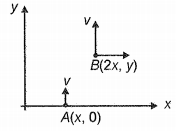A uniform electric field of strength E exists in a region. An electron is projected in the region perpendicularly with speed v as shown in the diagram. electron exits at point B. The electric field in the region is given by

1
2
3
4

A point charge is placed at the center of the spherical Gaussian surface. The electric flux through the surface is changed if the:
| 1. | sphere is replaced by a cube of the same volume. |
| 2. | sphere is replaced by a cube of half volume. |
| 3. | charge is moved off-centre in the original sphere. |
| 4. | charge is moved just outside the original sphere. |
In a region, volume charge density varies with radial distance r as where K is positive constant. The electric field E Varies with the radial distance in the region as
1.
2.
3.
4.
Which of the following is incorrect about electrostatic force?
1 it is conservative
2 it is a central force
3 Electrostatic field line never intersect
4 it also depends on the mass content of the body
Two charges each equal to are placed at the corners of an equilateral triangle of side a. The electric field at the third corner is is-
1
2
3
4
Given below are two statements:
| Statement I: | The mass of a body increases slightly when it is negatively charged. |
| Statement II: | Charging occurs due to the transfer of electrons. |
| 1. | Statement I is incorrect but Statement II is correct. |
| 2. | Both Statement I and Statement II are correct. |
| 3. | Both Statement I and Statement II are incorrect. |
| 4. | Statement I is correct but Statement II is incorrect. |
Given below are two statements:
| Statement I: | A positive point charge initially at rest in a uniform electric field starts moving along electric lines of forces. |
| Statement II: | A point charge released from rest in an electric field moves along the lines of forces. |
| 1. | Statement I is false but Statement II is true. |
| 2. | Both Statement I and Statement II are true. |
| 3. | Both Statement I and Statement II are false. |
| 4. | Statement I is true but Statement II is false. |
| Assertion (A): | Like charges may attract each other. |
| Reason (R): | unlike charges always attract each other. |
In the light of the above statements choose the correct answer from the options given below:
| 1. | Both (A) and (R) are true and (R) is the correct explanation of (A). |
| 2. | Both (A) and (R) are true but (R) is not the correct explanation of (A). |
| 3. | (A) is true but (R) is false. |
| 4. | Both (A) and (R) are false. |
Given below are two statements:
| Statement I: | Net charge of an electric dipole is zero |
| Statement II: | An electric dipole consists of two equal and opposite charges separated by a very small distance. |
| 1. | Statement I is false but Statement II is true. |
| 2. | Both Statement I and Statement II are true. |
| 3. | Both Statement I and Statement II are false. |
| 4. | Statement I is true but Statement II is false. |
A: Two spherical conductors having the same surface charge density will have the same electric field near their surfaces due to their own charge.
R: Surface charge density is a charge per unit area
1 If both Assertion & Reason are true and the reason is the correct explanation of the assertion, then mark(1)
2 If both Assertion & Reason are true but the reason is not the correct explanation of the assertion, then mark(2)
3 If Assertion is a true statement but Reason is false, then mark(3)
4 If both Assertion and Reason are false statements, then mark(4)






